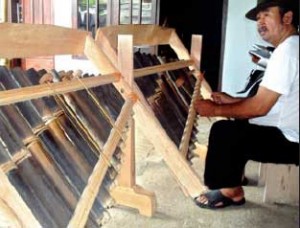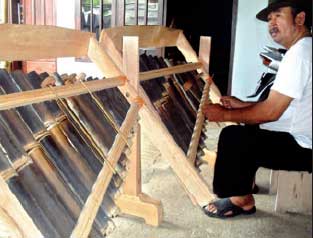 Usai Ditebang, Bambu Disimpan Minimal Setahun
Usai Ditebang, Bambu Disimpan Minimal Setahun
Angklung paglak diyakini sebagai kesenian pertama di Bumi Blambangan. Kesenian yang dimainkan empat orang itu muncul di tengah masyarakat sejak sekitar tahun 1890 silam. SUARA angklung terdengar begitu merdu di Desa Kemiren, Kecamatan Glagah, pagi itu (17/3). Iramanya yang mendayu-dayu membuat nuansa seni semakin kental menyelimuti desa adat Osing yang juga dikenal dengan desa wisata tersebut.
Semakin lama didengar, lantunan irama alat musik yang terbuat dari bambu itu semakin menggugah hati. Orang akan semakin tertarik untuk mencari di mana sumber suara tersebut. Ternyata, suara yang sangat indah itu berasal dari teras sebuah rumah yang berlokasi di tepi jalan desa setempat, tepatnya di Dusun Kedaleman, RT 1/RW 2, Desa Kemiren, Kecamatan Glagah. Saat didekati, seorang laki-laki paro baya tengah asyik memainkan alat musik tradisional tersebut.
Belakangan diketahui, pria paro baya yang kala itu mengenakan setelan kaus warna putih dan celana kain warna hitam, itu bernama Andi Supandi, 54, warga setempat. Seperti biasa, melihat sesuatu yang menarik untuk disajikan kepada pembaca, wartawan Jawa Pos Radar Banyuwangi pun langsung mengutarakan maksud untuk mewawancarai Andi Supandi. “Silakan. Saya akan jawab yang Adik tanyakan Saya punya literatur yang cukup komplet tentang asal usul angklung Banyuwangi,” ujar pria yang karib disapa Andik tersebut.
Singkat cerita, Andik pun membeber panjang lebar sejarah alat musik yang oleh masyarakat Banyuwangi dikenal dengan istilah angklung paglak tersebut. Menurut dia, angklung paglak adalah kesenian pertama di Bumi Blambangan. Angklung paglak yang biasa dimainkan empat orang, itu pertama kali diperkenalkan oleh Mbah Kebo alias Mbah Buang sekitar tahun 1880. Mbah Kebo adalah warga asal Bali yang karena memiliki persoalan keluarga di tanah kelahirannya, dia hijrah ke Banyuwangi dan lantas bermukim di wilayah yang saat ini dikenal dengan Kampung Bali, Kelurahan Pengajuran, Kecamatan Banyuwangi.
Andik menambahkan, pada perkembangan selanjutnya, tepatnya pada masa kepemimpinan Bupati Notodiningrat, yakni pejabat asal Malang yang berdinas di Surakarta dan lantas dipindah ke Banyuwangi oleh pihak Belanda, ada seorang warga menemukan gamelan yang terbuat dari perunggu (gender). Warga tersebut lantas menyerahkan gender yang dia temukan kepada bupati. Dari tangan bupati, gender itu lantas diserahkan kepada Mbah Kebo. “Oleh Mbah Kebo, gender tersebut lantas dikombinasi dengan angklung paglak.
Jadilah angklung Bali-balian atau yang sekarang lebih dikenal dengan istilah angklung caruk,” ungkap budayawan asli Osing yang satu ini. Mengapa disebut angklung caruk? Menurut Andik, hal itu disebabkan karena setiap kali pertunjukan, ada dua grup angklung Bali-balian yang dipertemukan (kecaruk). “Saat bertemu itulah, dua grup bersaing. Bahkan sampai menggunakan ilmu santet. Nah, Mbah Kebo tidak setuju dengan persaingan yang tidak sehat tersebut. Akhirnya, dia melebur gender yang dia miliki dan ditambahkan perunggu.
Jadilah gamelan janger,” cetusnya. Dikatakan, Mbah Kebo lantas mendirikan grup janger pertama di Desa Patoman, Kecamatan Rogojampi. Pada waktu itu, wiyogo (gamelan) dan kostum janger mengadopsi budaya Bali. Namun, pemain jangernya asli orang Osing. Sedangkan antawacana (dialog) menggunakan Bahasa Kawi atau Bahasa Jawa ngoko. “Jadi, Janger Banyuwangi merupakan perpaduan etnis Bali, Osing, dan Jawa,” kata dia. Kembali ke cerita tentang angklung, meskipun Mbah Kebo keluar dari omunitas kesenian tersebut, tetapi kesenian angklung caruk tetap bertahan di tengah masyarakat.
Bahkan, kesenian tersebut masih lestari hingga saat ini. Hanya, imbuh Andik, kesenian angklung caruk saat ini sudah tidak lagi diwarnai saling serang menggunakan ilmu santet. Usut punya usut, selain tahu banyak asal mula kesenian angklung paglak, Andik juga piawai membuat alat musik yang terbuat dari bambu tersebut. Dia menjelaskan, nyaris semua jenis bambu bisa dikreasikan menjadi angklung, asalkan bambu tersebut tumbuh di atas lahan kering, seperti cadas, lahan berbatu, dan lain sebagainya.
“Proses pengerjaannya harus benar. Bambu tidak boleh dipanaskan di bawah sinar matahari langsung agar suaranya mendengung dan nge-bas,” tuturnya. Persyaratan mutlak lain membuat angklung, bambu harus ditebang pada bulan kedelapan kalender Masehi. Sebab, pada bulan Agustus, tidak muncul tunas (rebung) pada rumpun bambu. “Kalau muncul rebung, batang bambu dewasa mengandung zat manis untuk “menyusui” rebung. Maka jika ditebang, maka bambu dewasa tersebut mudah terserang penyakit yang oleh warga Banyuwangi disebut bubuk,” terangnya.
Masih kata Andik, masyarakat Banyuwangi juga meyakini bahwa memotong bambu untuk bahan baku angklung paling tepat dilakukan pada hari Sabtu pasaran Pahing. Pasalnya, Sabtu Pahing memiliki perhitungan tertinggi, yakni Sabtu = 9 dan Pahing = 9. “Selain itu, Pahing adalah pasaran pahit. Jadi batang bambu tidak mudah diserang bubuk,” rincinya. Pasca ditebang, batang bambu harus diletakkan di tempat yang terhindar dari sinar matahari langsung selama setahun.
Penyimpanan itu tidak boleh dilakukan asal-asalan. Batang bambu harus diletakkan dengan posisi berdiri (vertikal) agar kandungan airnya turun. Sedangkan jika diletakkan dengan posisi horizontal, maka kandungan airnya akan bergeser ke samping. Setelah disimpan selama setahun, bambu bahan baku angklung dipotong setiap dua ruas. Potongan bambu itu lantas disimpan di pogo (tempat penyimpanan semacam rak bambu yang diletakkan di bawah atap dapur) selama tiga bulan sepuluh hari.
Setelah itu, barulah bambu tersebut bisa diproses menjadi angklung. Andik mengaku angklung hasil kreasinya sudah sampai di tangan sejumlah pembeli asal seantero Tanah Air, terutama dari kalangan seniman. “Harga satu angklung bervariasi, antara Rp 300 ribu sampai Rp 5 juta. Tergantung ukuran dan tingkat kesulitan pengerjaannya,” jlentrehnya. Andik menjelaskan, angklung seharga Rp 5 juta, tiang (caglak)-nya menggunakan kayu berukir, dan tebeng-nya menggunakan maskot tertentu.
Misalnya maskot gandrung dan lain-lain. “Ukiran di caglak angklung biasanya berupa ular berkepala tokoh wayang. Itu adalah simbol kesenian, bukan simbol masyarakat Banyuwangi. Simbol ular berkepala manusia, itu mengandung makna manunggaling kaula gusti, yakni keinginan pelaku seni untuk mendekatkan diri dengan Tuhan lewat kesenian. Makanya simbol tersebut banyak ditemukan di mahkota gandrung, barong, dan lain-lain,” pungkasnya. (radar)








